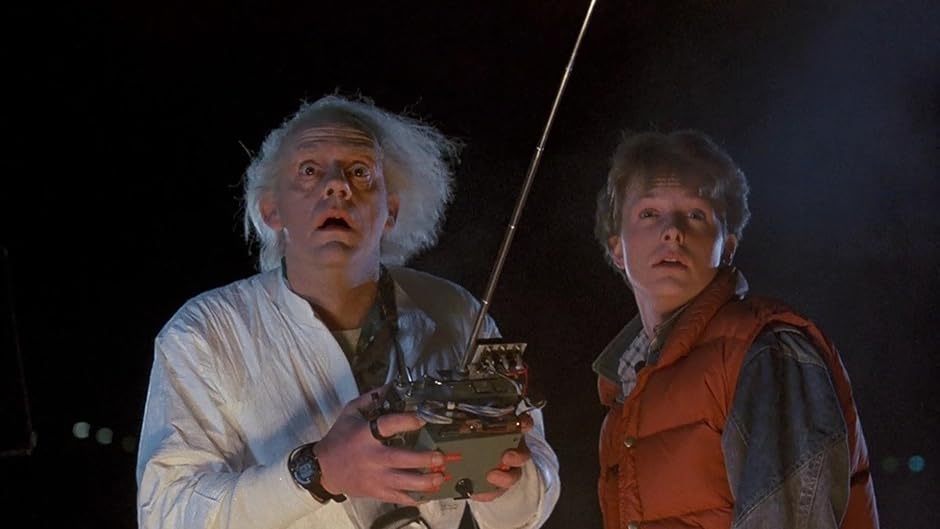Narrative Theory
There are 3 main theories of narrative that coincide with many different stories; Todorov's cyclical Theory of Narrative, Levi-Strauss's Theory which is based on binary opposites, and Vladmir Propp's Theory of archetypes.
In this 1980s sci-fi classic, small-town California teen Marty McFly (Michael J. Fox) is thrown back into the '50s when an experiment by his eccentric scientist friend Doc Brown (Christopher Lloyd) goes awry. Traveling through time in a modified DeLorean car, Marty encounters young versions of his parents (Crispin Glover, Lea Thompson), and must make sure that they fall in love or he'll cease to exist. Even more dauntingly, Marty has to return to his own time and save the life of Doc Brown.
 |
| Christopher Lloyd as Doc Brown and Michael J. Fox as Marty McFly |
In this 1980s sci-fi classic, small-town California teen Marty McFly (Michael J. Fox) is thrown back into the '50s when an experiment by his eccentric scientist friend Doc Brown (Christopher Lloyd) goes awry. Traveling through time in a modified DeLorean car, Marty encounters young versions of his parents (Crispin Glover, Lea Thompson), and must make sure that they fall in love or he'll cease to exist. Even more dauntingly, Marty has to return to his own time and save the life of Doc Brown.
The narrative theory that can be applied to Back to the Future is Todorov's cyclical narrative; this theory outlines a story with it being in equilibrium at the starting point - the characters and setting is in order and balance:
- The equilibrium is in 1985, where Marty is having a normal day with his family and going to school as usual.
The second stage is disequilibrium, where order is disrupted in some type of way:
- This would apply in two parts of the movie: when Doc Brown is shot dead by Libyan nationalists for stealing plutonium for the time machine, Marty escapes by getting inside the DeLorean and travelling back in time to 1955. While he is there, he disrupts the meeting of his parents, his young mother falls in love with him under his pseudonym 'Calvin Klein', which shifts the space-time continuum and threatens to obliterate his existence in the future; as well as this, he is being tormented by his father's employer, Biff, who is the school bully.
 |
| Marty and Doc Brown use thunder power to travel back to 1985 |
The last stage of the cycle is restoration, where the protagonists attempt to reinstate order and bring the narrative back to equilibrium (happy ending, usually):
- In Back to the Future, the restoration stage occurs when Marty gets his parents together at the school's 'Enchantment Under the Sea' dance and works with 1955 Doc Brown to fix the broken DeLorean using electric lines and thunder so that Marty can travel back to 1985 and save future Doc Brown from getting killed.
The second theory is Claude Levi-Strauss's theory of binary opposites within a narrative. Levi-Strauss believed that there is always binary opposition in every tale. In Back to the Future this may be evident also:
- Protagonist vs Antagonist = Marty vs Biff
- Past vs Future = 1955 vs 1985
- Old vs Young = 1955 George and Lorraine McFly vs 1985 George and Lorraine McFly
- Victim vs Bully = George and Biff
The last theory is Vladmir Propp's theory of archetypes; this theory suggests that there are 7 main types of character that appear in different narratives and they all behave in the same way. Some characters may represent more than one archetype which happens in Back to the Future:
 |
| From Left: Marty McFly, Doc Brown, 1955 Lorraine, 1955 George and 1955 Biff |
- Hero: is on a quest to restore equilibrium > Marty McFly
- Villain: disrupts the equilibrium and operates against the hero > Biff Tannen
- Dispatcher: sends the hero on their quest to restore equilibrium > 1985 Doc Brown
- Donor: gives the hero something to aid them in their quest > 1985 Doc Brown
- Helper: assists the hero in restoring equilibrium > 1955 Doc Brown
- False Hero: takes credit for the hero's actions and may deceive hero > 1955 George McFly
- Princess: needs to be rescued by the hero and can be threatened/ compromised by villain >1955 Lorraine McFly



Comments
Post a Comment